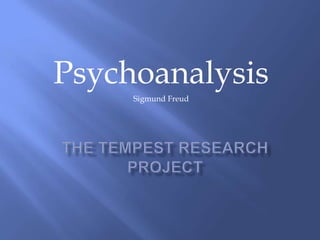The Tempest Research Project
Sigmund Freud developed psychoanalysis in the late 19th century. Some key tenets are that human behavior is determined by unconscious drives, especially from early childhood, and that bringing the unconscious into consciousness can help address mental health issues like neurosis. While Jung initially collaborated with Freud and supported psychoanalysis, he later disagreed with Freud's view of the unconscious and proposed the additional concept of a collective unconscious shared among all people. Freud's early work studied hysteria and the interpretation of dreams, and he later developed the structural theory of the id, ego and superego. Psychoanalysis has since been expanded upon and challenged but continues to influence understanding of the mind.

Recommended
Recommended
More Related Content
What's hot
What's hot (20)
Viewers also liked
Viewers also liked (20)
Similar to The Tempest Research Project
Similar to The Tempest Research Project (17)
Recently uploaded
Recently uploaded (20)
The Tempest Research Project
- 1. Psychoanalysis Sigmund Freud
- 2. Psychoanalysis is a psychological and psychotherapeutic theory conceived in the late 19th and early 20th centuries by neurologist Sigmund Freud. The basic tenets of psychoanalysis include; Human behaviour, experience and cognition are largely determined by irrational drives. Those drives are largely unconscious; Attempts to bring those drives into awareness meet psychological resistance in the form of defence mechanisms; Development is largely determined by early stages in childhood; Results in mental health such as neurosis, neurotic traits, anxiety, depression etc. can be caused by conflicts between conscious views of reality and unconscious and repressed state of mind. Though skilled guidance, liberation from the effects of the unconscious material is achieved by bringing this material into a conscious state.
- 3. Freud sent a collection of his latest published essays to Jung in Zurich, which marked the beginning of an intense correspondence and collaboration that lasted six years and ended in May 1913. At this time Jung resigned as the chairman of the international psychoanalytical Association, where he had been elected with Freud's support. Jung and Freud influenced each other during the intellectually formative years of Jung's life. Jung, who had become interested in psychiatry as a student and became familiar with Freud's idea of the unconscious through Freud's The Interpretation of Dreams (1900) and was a proponent of the new "psycho-analysis." At the time, Freud needed collaborators and pupils to validate and spread his ideas. Jung's primary disagreement with Freud stemmed from their differing concepts of the unconscious. Jung saw Freud's theory of the unconscious as incomplete and unnecessarily negative; According to Jung, Freud conceived the unconscious solely as a repository of repressed emotions and desires. Jung agreed with Freud's model of the unconscious, what Jung called the "personal unconscious", but he also proposed the existence of a second, far deeper form of the unconscious underlying the personal one. This was the collective unconscious; Carl Gustav Jung - “My thesis then, is as follows: in addition to our immediate consciousness, which is of a thoroughly personal nature and which we believe to be the only empirical psyche (even if we tack on the personal unconscious as an appendix), there exists a second psychic system of a collective, universal, and impersonal nature which is identical in all individuals. This collective unconscious does not develop individually but is inherited. It consists of pre- existent forms, the archetypes, which can only become conscious secondarily and which give definite form to certain psychic contents.”.
- 5. Freud's first Study was in 1895 where he presented a theory to explain hysterical symptoms, in Studies on Hysteria which was co-authored with Josef Breuer. The book presents two different viewpoints: a neurophysiologic and a psychological cause for hysteria. Breuer describes the causes of hysteria by supporting a neurophysiologic cause, while Freud uses a psychological standpoint. People who are "hysterical" often lose self-control due to an overwhelming fear that may be caused by multiple events in one's past that involved some sort of severe conflict. He contended that at the root of hysterical symptoms were repressed memories of distressing occurrences, almost always having direct or indirect sexual associations.
- 6. Freud formulated his second psychological theory, which postulates that the unconscious has or is a "primary process" consisting of symbolic and condensed thoughts, and a "secondary process" of logical, conscious thoughts. This theory was published in his 1900 book, The Interpretation of Dreams; The book introduces Freud's theory of the unconscious with respect to dream interpretation, and also first discusses what would later become the theory of the Oedipus complex.
- 7. In this theory, which was mostly later supplanted by the Structural Theory, unacceptable sexual wishes were repressed into the "System Unconscious," unconscious due to society's condemnation of premarital sexual activity, and this repression created anxiety. His early formulation included the idea that because of societal restrictions, sexual wishes were repressed into an unconscious state, and that the energy of these unconscious wishes could be turned into anxiety or physical symptoms. Therefore the early treatment techniques, including hypnotism and abreaction, were designed to make the unconscious conscious in order to relieve the pressure and the apparently resulting symptoms.
- 8. Following the death of Freud, a new group of psychoanalysts began to explore the function of the ego; “The structural theory" of an id, ego, and superego, Freud noted now considering that repression was only one of many defence mechanisms, and that it occurred to reduce anxiety. Freud laid out how intrapsychic conflict among drive and superego (wishes and guilt) caused anxiety, and how that anxiety could lead to an inhibition of mental functions, such as intellect and speech. The group built upon understandings of the synthetic function of the ego as a mediator in psychic functioning. His work has since been challenged, developed and refined, but the discovery of his studies in psychoanalysis, has and will carry on helping others to understand mental illnesses.